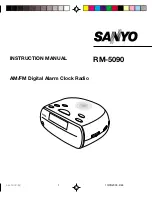
24
5000/5100 Series Digital Analog Clocks Installation and Operation Manual
Chapter 2: ADC-5100 Series Analog Digital Clocks
General Operation
Clock Control Modes
Primary Reference (timecode) Mode
No setting of time is required when input timecode is provided to the
ADC Series clock. Once valid timecode is detected, either SMPTE or
EBU, the clock will begin to self-set. The self-setting procedure moves
the hands at a rapid rate in either the clockwise or counter-clockwise
direction until the correct position is obtained. If the hands and the
correct time are the maximum distance apart (6 hours), the self-setting
process may require up to 15 minutes to complete.
Once the clock hands match the correct time, as indicated by the input
timecode, the error LED on the clock face will extinguish to indicate
that the clock is synchronized with the timecode.
The clock may require up to 2 additional minutes of normal operation
(following self-set) for the second hand to completely re-synchronize.
This is due to accumulated gear slippage during counter-clockwise
movements.
If there is a failure of the input timecode, the clock will switch to the
Secondary Reference as selected by DIP switch SW4 on the rear panel.
Either the clock’s own internal crystal or the power line frequency may
be selected as the secondary reference. Both will provide the clock with
a timebase during the absence of input timecode. (Note that either a 50
Hz or 60 Hz power line frequency is suitable for the timebase, since the
clock automatically selects the correct frequency available.)
To signal the failure of the input timecode, the error LED on the clock
face will flash at a rate of twice per second. When correct timecode is
re-established, the clock will again self-set to the new time, and the
error LED will extinguish.
Similarly, if there is an error in the input timecode, the clock will
automatically switch to the secondary reference, and the error LED will
flash.
Note
Impulse input is not currently recognized by the ADC-5100 Series
clocks.















































